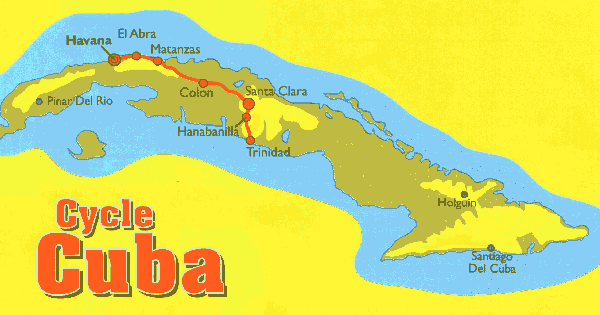

![]()
![]()
![]() ...ahem...
...ahem...
5 Days of Blood, Sweat, Tears and Toil for the National Deaf Children's Society
well, a rough version to be going on with...
We depart from Heathrow at 4.30am on 23 January. Many of us, including myself were not aware that there was a 4.30am,but there is plenty of time to sleep on the plane and the jetlag means the daily 6.30am wake-up calls feel more like mid-morning.
The trip from Jose Marti airport to our hotel in Miramar is remarkable in itself - we ride in buses of an advanced age through the suburbs of Havana. Everything looks very run-down and there is little traffic on the road. At first we assume this is due to the petrol shortage but we later find that it's because we arrived on Sunday evening - there is generally quite a lot of traffic on the road.
We ride through the city, open mouthed at the deco architecture, the '50's cars and the people. The grid layout and the wide streets give the city the feel of an older US city, except for the sultry ambience and the palm trees. The atmosphere seems very relaxed - drivers are generally courteous and patient and there are bicycles everywhere, ridden somewhat erratically, often carrying several passengers. I want to get out of the bus and onto the street - already it's clear that a two week stay in this country is not going to be nearly enough and I am planning to return.
We tour Havana - a beautiful and exotic city in an advanced state of decay. We have been introduced to the Mojito, the Cuban national drink - rum, lime, mint and sparkling water - so several of the 80-strong group are already nursing hangovers.
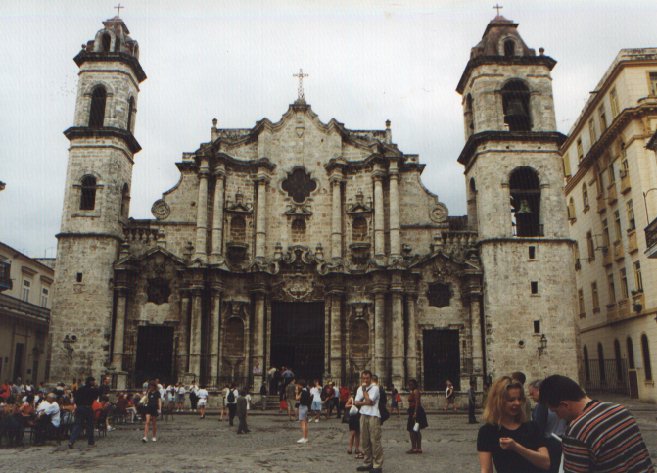 The
cathedral in Old Havana. Catholicism is more tolerated recently -
Castro needs all the friends he can get now the Soviet Union has
collapsed. There are quite a few posters commemorating the Pope's
recent visit. Apparently Santeria, a hybrid of Catholicism and
African religions along the lines of Candomble or Voodoo is the de
facto main religion. We never get around to visiting a
Santeria house. Just one more reason to return...
The
cathedral in Old Havana. Catholicism is more tolerated recently -
Castro needs all the friends he can get now the Soviet Union has
collapsed. There are quite a few posters commemorating the Pope's
recent visit. Apparently Santeria, a hybrid of Catholicism and
African religions along the lines of Candomble or Voodoo is the de
facto main religion. We never get around to visiting a
Santeria house. Just one more reason to return...
We spend the night at El Abra, in a kind of Cuban holiday camp. This is a lot more basic than the Miramar hotel and some of the group begin to experience culture shock, particularly when they have to chase frogs and snakes from their beds before retiring to sleep. We are given a Salsa lesson and it quickly becomes clear that while Cubans are born to dance, English people are not.
We are introduced to our bikes in El Abra. Happily these are good quality & not the Flying Pigeon bikes imported from China in millions to beat the petrol shortage. Tim and I go for a test ride through the palm trees in the twilight.
Ride Day 1 - El Abra-Matanzas
We set off along the north coast. At the first water stop I apply the factor 50 sun-block I have brought. People begin to stare at me in a rather unnerving fashion - later I find that the stuff is completely white and I resemble a ghost. Still, they laugh on the other side of the faces when they start to burn, and the factor 50 is soon in demand...
Matanzas means Place of Slaughter - variously thought to refer to a massacre of the original native inhabitants and a later pork market. Our hotel initially has no water - as we move away from tourist resorts and into the real Cuba, luxuries like hot water and toilet seats become increasingly rare. To encourage marriage, the Cubans give honeymooning couples free holidays in this hotel. Suggestive statues of naked women dot the grounds as encouragement.
The air quality in Matanzas is not good. Cuba has oil reserves along the north coast which are now being exploited, but the oil is of very poor quality and a pall of sulphurous, noxious smoke from the nearby refinery hangs over the town. Given the climate it seems remakable that the Cubans haven't made more efforts to exploit solar and wind power. I make a note to write to Fidel about this...
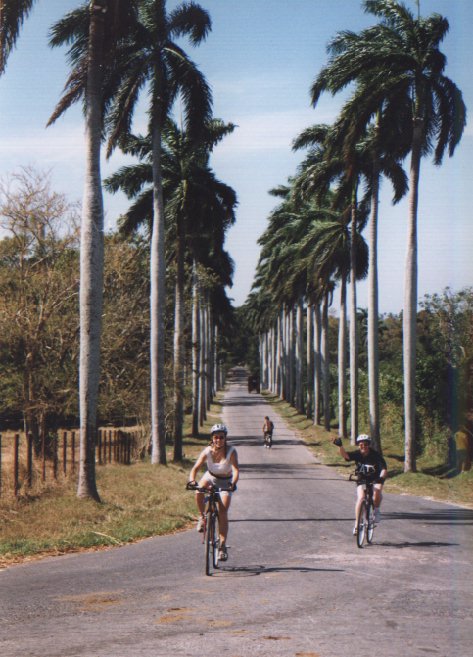 Ride Day 2
-Matanzas - Colon
Ride Day 2
-Matanzas - Colon
This is a longer day - we ride inland across Cuba through farmland. This picture shows the entrance to Cuba's horticultural institute - owned by a major US university until the 1959 revolution.
We see plenty of revolutionary billboards as we cycle. It is difficult to gauge the significance of these - do they find an echo with people or are they regarded as just government propaganda? Whichever, the revolution probably remains more popular in the country than in the cities, despite the recent economic hardship - the return to ploughing with oxen and so on.
We are now well outside the tourist areas and 80 English people on bikes present a truly unusual sight to the Cubans. Mothers bring their children out to watch us go past and schoolkids cheer, wave and try out their English, which mainly consists of "bye-bye".
ColÚn (the Spanish for Columbus) is rarely visited by foreigners and it is quite a big event when we hit town. Apparently the hotel has been entirely repainted with the proceeds from previous NDCS tours. There is no hot water but the staff really try hard - the towels are sculpted into the shape of swans.
A local cabaret is gives a special midweek performance in our honour with unexpectedly spectacular dancing and a somewhat less spectacular magic act by Oscar, who is a dead ringer for Gomez from the Addams family. Later, Tim and I are approached in the town square by two of the beautiful dancers from the cabaret who invite us out for a drink. Unbelievably I hear myself decline as we are too tired and have to sleep ready for the ride tomorrow! We return to the hotel and I cry myself to sleep.
Ride Day 3 Colon-Cienfuegos
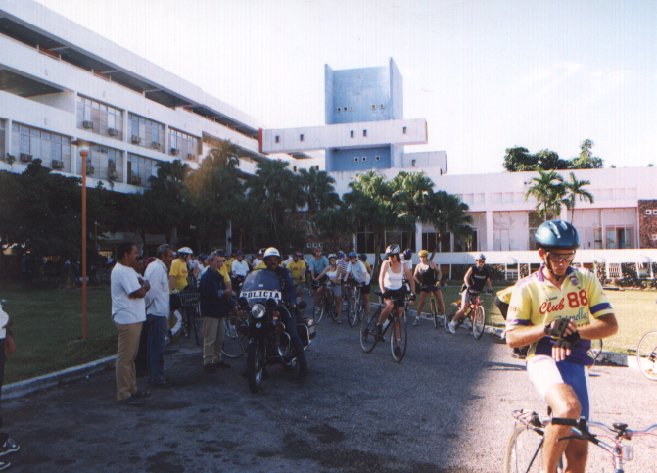 The
longest day - almost 70 miles across flat plains covered with
sugar cane. Although the Cubans have tried to diversify their
economy over the years, they have not really succeeded . Sugar is
still the main visible export and a poor crop or fall in world
prices hits the country hard, particularly since Russia no longer
buys at above market prices.
The
longest day - almost 70 miles across flat plains covered with
sugar cane. Although the Cubans have tried to diversify their
economy over the years, they have not really succeeded . Sugar is
still the main visible export and a poor crop or fall in world
prices hits the country hard, particularly since Russia no longer
buys at above market prices.
I am discovering to my satisfaction that I'm one of the fittest people on the ride and can stay at the front without really exerting myself. We bowl along in a pack, oblivious to the "boy racer" taunts of those behind us, and eat up the miles despite the headwind. Others find it harder going and by lunchtime there are plenty of bikes stacked in the support truck.
We have a police escort throughout the ride, not to prevent us talking to Cubans - we encounter no barriers of this kind during our stay - but to stop traffic while we pass. It often takes half an hour for the ride to go by and the Cuban drivers are amazingly good-natured and patient. On the right above is Norberto, who trains the Cuban Triathlon team and is our guide and front marker for the trip.
As we reach Cienfuegos I realise that my ticket and passport are missing from my back pocket. It must fave fallen out of my back pocket at lunchtime. This looks like being a real pain, with visits to the consulate and so on. When we arrive at the hotel I tell this to Tim who produces the missing items and tells me he picked my pocket as we were cycling. With friends like this...
Ride Day 4 Cienfuegos-Hanabanilla
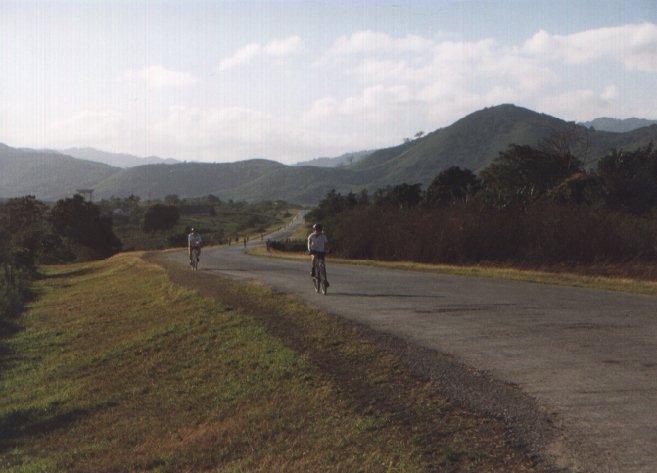 We head up into
the Escambray Mountains, where Che Guevara gathered his forces
before the final success of the Revolution. The land is
breathtakingly beautiful here and it's hard to keep your eyes on
the (increasingly potholed) road.
We head up into
the Escambray Mountains, where Che Guevara gathered his forces
before the final success of the Revolution. The land is
breathtakingly beautiful here and it's hard to keep your eyes on
the (increasingly potholed) road.
At several of our frequent water stops local people gather and watch us. When we leave they quickly gather up our empty plastic mineral water bottles, which clearly have considerable value in the poorer regions of the country - one of many guilt-inducing aspects of the trip.
While we see no-one obviously starving and education and health care remain good by Third World standards, ordinary Cubans are clearly having a hard time. We give away what we can - pens, soap, toothpaste and other toiletries are particularly scarce.
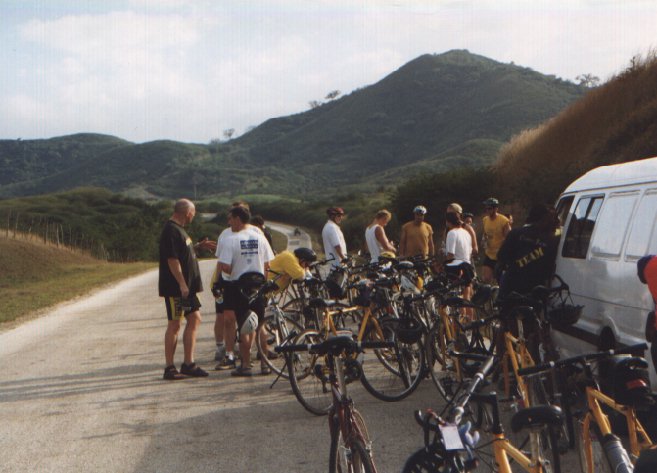 Rest
stop - Sierra Escambray in the background. The last 8km of the
ride are increasingly steep and though I am the second NDCS rider
up the big hill (behind Ken who is half my age and has brought
his own titanium bike!) the only fun part is getting to the top
and being able to stop pedalling. The hotel at Hanabanilla makes
up for it - it looks out over a spectacular lake and has showers
that knock you off your feet. We are given a Cuba Libre and a
cheer as we reach the top.
Rest
stop - Sierra Escambray in the background. The last 8km of the
ride are increasingly steep and though I am the second NDCS rider
up the big hill (behind Ken who is half my age and has brought
his own titanium bike!) the only fun part is getting to the top
and being able to stop pedalling. The hotel at Hanabanilla makes
up for it - it looks out over a spectacular lake and has showers
that knock you off your feet. We are given a Cuba Libre and a
cheer as we reach the top.
Ride Day 5 - Hanabanilla - Trinidad
For the first time I wake up with a strong feeling that I don't want to get back on the bike. Still, it's the last day and how bad can it be?
We start by hurtling down the hill we cycled up yesterday. Our enjoyment is tempered somewhat by the knowledge that Louise Maunder from the NDCS fell off here at 40mph last time round and broke her arm. The rest of the day is uneventful, except for the even more spectacular scenery, and a bus lift over a really steep and rough stretch which is considered too dangerous for us to attempt.
We arrive at Trinidad, a really pretty Spanish Colonial town, in the late afternoon. The ride is over and it feels like a serious anti-climax. We are mobbed by children as we reach the town. These are streetwise kids not at all like the children in the countryside. Plastic water bottles will not do the trick - they are after our gloves and lycra cycling gear. Trinidad was one of the first Cuban towns to be opened up to tourism and it shows. Though people are still friendly, they are far more geared up to trying to sell you things.
The Hotel Playa Ancon has cancelled our reservation so we have been booked into a health spa in the mountains which is apparently mainly used by high ranking Party officials. The place is huge and monolithic - we immediately assume it's eastern bloc Brutalism but in fact like many such buildings in Cuba it predates the revolution - this one was built in the 1930's and appears to be in Mussolini's fascist tradition. Those of us who do not immediately fall asleep have a sauna and massage and later dance until a very late hour. All that lycra and exertion has led to some powerful bonding and things get a bit emotional...
 Me and
Tim,somewhere in Cuba... The NDCS estimate the length of the ride
at 260 miles. We both went the whole distance without having to
once get off and push. Too easy! Next stop Cycle India in
February 2000???
Me and
Tim,somewhere in Cuba... The NDCS estimate the length of the ride
at 260 miles. We both went the whole distance without having to
once get off and push. Too easy! Next stop Cycle India in
February 2000???
The last day should be for rest and recuperation at the beach hotel but someone has had the idea of a Gala Evening where we are supposed to provide our own entertainment. Shaun, myself and a few others have rather rashly agreed to have a crack at a "Good Vibrations" mutilated by cycling references so the rest day is spent frantically writing and rehearsing until we get to an acceptable level of embarrassment.
In the morning we say farewell to those returning immediately to the UK and the rest of us scatter round Cuba. Tim goes scuba diving and gets a tow from a Whale Shark, a story he later relates to everone we meet. After the tenth repetition the story has lost its magic for me and I start leaving the room when I hear the word "scuba".
Several of us stay in Trinidad in Casas Particolares - Cubans are now allowed to rent out rooms in their homes to tourists, on payment of a licence to the government. The black market is thriving and we eat the best food of our stay in some of these places, including shrimps which are subject to a government monopoly and not meant to be available privately. Real Cuban food is far better than the hotel food would suggest, an eclectic mixture of Spanish and African influences. We are also matter-of-factly offered chicas - girls - by one casa proprietress, with what can only be described as a twinkle in her eye. A far cry from the traditional British seaside landlady, clearly. We decline on the grounds that we have girlfriends back home - "ah, well, they're not here, are they?" she says. Tim has a perfect excuse - "Yo soy un maricon" - but elects not to use it, probably wisely - though homosexuality is far less persecuted in Cuba than it once was it's best not to tempt fate.
While those of the casas working fiddles of one sort or another have secret doorbell rings to distinguish between personal callers and the police, and we hear about a 6-year jail sentence for a black-market meat merchant, the Cuban authorities appear to turn a blind eye to quite a lot of activities, possibly understanding people's need to make ends meet. Enforcement of laws also appears to vary from one region to another and from one time to another. We later discover a crackdown had just started but we saw little sign of it; certainly the cigar sellers were not noticeably affected.
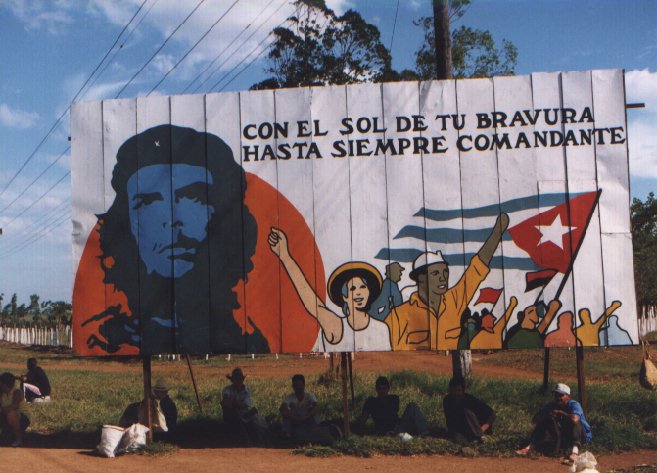 Pictures of
CheGuevara are everywhere. Whether he would approve of the
compromises Castro is now making with capitalism in order to keep
the economy afloat is another matter. Tourism is now the biggest
source of foreign exchange and Cubans are allowed to run small
businesses - although not to employ anyone outside their
immediate families.
Pictures of
CheGuevara are everywhere. Whether he would approve of the
compromises Castro is now making with capitalism in order to keep
the economy afloat is another matter. Tourism is now the biggest
source of foreign exchange and Cubans are allowed to run small
businesses - although not to employ anyone outside their
immediate families.
The currency situation is quite complicated - the peso is the official currency and everyone who works for the government (ie. almost everyone) is paid in pesos. Though rates of pay are low - a teacher gets 300 pesos a month (about US$15) prices are very low too. However many peso goods are rationed, or simply not available. Meanwhile, the US dollar was legalised in 1994 to try and control the black market by legitimising it, and there are government-run "dollar shops" where everything is available, but at world market prices or higher. About half of Cubans have access to dollars one way or another. We are told that it is not possible to live on the government salary so "how the other half live" is a matter of real concern. Still, everyone seems agreed that things are getting better after a low point in about 1993.
Many Trinidaderos keep a pig in their back yard. A friend explains to the landlady of his casa particolare that this would not be allowed in London. "Ah, so there is no freedom in your country" she says.
In general, the Cuban people are lovely -friendly, open and generous. Time and again we are invited into their homes for rum, for dinner or just for a chat. Although there is often an element of self-interest involved - we are able to provide soap, rum and dollars - people are also genuinely friendly, keen to talk about their lives and ask about ours. These are the best memories most of us will take home from Cuba.
Tourists are popular here despite some of the less palatable aspects brought about by their presence - everyone acknowledges the need for foreign exchange so the country can support itself in what is called the Special Period in Time of Peace - basically a siege economy. It is worrying to see some of the effects of tourism - the "apartheid" beach hotels where Cubans are not allowed, the many places where they cannot now afford to go, the begging, hustling, prostitution and to a lesser extent petty crime which is beginning to spring up. This said, Cuba is a far cry cry from most Latin American countries in this respect and generally it appears to be a civilised and safe society.
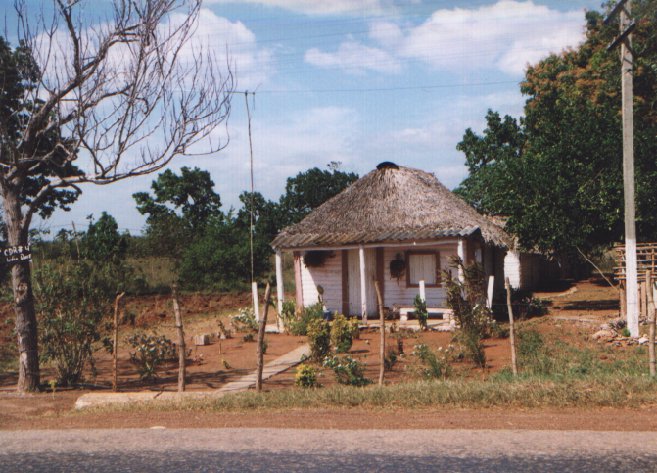 This is a bohio or
traditional thatched cottage. Not many are in as good condition
as this one, to be honest - paint seems to be one of the main
items hit by the US economic embargo. The only town in good
condition is Trinidad which receives international funds as a UN
world heritage site.
This is a bohio or
traditional thatched cottage. Not many are in as good condition
as this one, to be honest - paint seems to be one of the main
items hit by the US economic embargo. The only town in good
condition is Trinidad which receives international funds as a UN
world heritage site.
There are certainly questions to be asked about the handling of the economy and the lack of contingency plans for the collapse of Soviet support. I seems hard to believe that such a fertile country cannot be self-sufficient in food, for example.
Although there is no free press, some people are quite vocal about Castro's government, whether for or against, and the economic system. Even those who hate Castro are against the US blockade..
We fly back to Havana and a couple of days later we are back in cold, wet England, looking for the ingredients for Mojitos, still dreaming of Cuba. An amazing place, one that Gabriel Garcia Marquez could not have invented in his wildest dreams. Two weeks was certainly not enough. As Federico Garcia Lorca said - "If I disappear, look for me in Cuba."